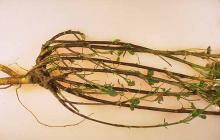Cause A fungus, Phoma medicaginis, which persists in crop refuse, infected crowns, and taproots. The disease may also spread through infected seed. Disease is most common in wet springs when it reduces yield and quality of first cuttings.
Symptoms Dark brown or black spots (tar spots) appear on stems, leaves, and leaf petioles. Spots often coalesce, forming irregularly shaped lesions. Leaves turn yellow and drop from the plant. Stems may be girdled and killed. Infected seed pods discolor and shrivel.
Cultural control
- Plant adapted recommended varieties.
- Rotate to grass or cereal crops free from volunteer legumes.
- Sow certified pathogen-free seed. Seed from arid regions is less likely to be infected.
- If disease is present, cut early to reduce foliage loss.
Chemical control Foliar fungicides effectively reduce disease severity and may be considered for alfalfa seed crops.
- Priaxor Xemium (Group 7 + 11) at 4 to 6.9 fl oz/A on 14- to 21-day intervals. Do not make more than 2 applications per cutting or 3 applications per year. Preharvest interval is 14 days. 12-hr reentry.
- Quadris Flowable (Group 11) at 6 to 15.5 fl oz/A on 7- to 14-day intervals. Do not apply more than 15.5 fl oz/A per cutting. Preharvest interval is 14 days for grazing or harvest for forage and hay. 4-hr reentry.
- Vacres (potassium bicarbonate) at 2.5 to 5 lb/A on 7- to 14-day intervals. Preharvest interval is zero (0) days. 4-hr reentry.


